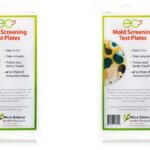Mold can grow in almost any area of the home, and its presence can range from light infestations to severe outbreaks. Choosing the right home mold test kit depends on the area being tested, the extent of the mold growth, and the specific conditions of that space.
Different kits are designed to detect mold effectively in varying situations, and though all kits can detect mold in your home, you need to know which test kits are best for different areas and stages of mold infestation.
Light Mold Infestation
For light mold infestations, where you suspect mold due to mild odors or small visible patches, an air sampling mold test kit is often sufficient. These kits capture airborne mold spores to identify their type and concentration.
These kits typically come with a petri dish and growth medium. You leave the dish open in the area for a set period to collect mold spores. They are great for bedrooms, living rooms, or other spaces with light mold presence and are easy to use without requiring professional assistance.
You can also use these kits in areas with minor visible mold or slight musty smells, such as on window sills or behind furniture. They are particularly useful for determining if there’s mold in places that aren’t immediately visible, like within wall cavities or under carpets.
Heavy Mold Infestation
In cases of heavy mold infestation, where visible patches cover larger areas, a swab test kit or professional-grade mold testing kit is better. These kits are designed to collect samples from surfaces with heavy mold growth and provide more detailed results.
Swab kits include a swab that you use to collect mold directly from the affected surface. They are ideal for areas like walls, ceilings, or furniture with significant mold growth. A professional test kit often includes both air and surface testing and may require lab analysis.
They provide detailed information about the mold type and its potential hazards, making them ideal for severe infestations where health risks are a concern. Use these kits in kitchens, bathrooms, or any area with visible mold colonies, especially if the mold has spread extensively. For large infestations, they can help determine if professional remediation is needed.
Crawl Spaces
Crawl spaces are notorious for high humidity and poor ventilation, making them prime spots for mold. Since mold here is often out of sight, an air pump mold test kit is recommended. These kits use an air pump to collect spore samples from hard-to-reach spaces, ensuring accurate results.
These kits are more precise than basic air sampling kits and are effective in small, enclosed spaces like crawl spaces. They can detect mold spores that may be circulating in the air. They are ideal to use in tight, dark, and poorly ventilated areas, especially if you notice a musty smell or suspect moisture issues in the crawl space.
Basements
Basements are common sites for mold growth due to high moisture levels, poor air circulation, and water intrusion. Both air and surface test kits can work here, depending on the extent of the mold problem.
For small amounts of mold or when testing for airborne spores, a simple DIY kit can suffice. You can also use home mold test kits with test plates, and air pumps, as using them in combination allows you to test both air and surfaces, making them ideal for basements with visible mold growth or widespread dampness.
Use these kits to test walls, floors, and corners of the basement, particularly near water heaters, sump pumps, or any areas prone to leaks.
Choosing the Right Kit for Different Stages
Selecting the right mold test kit and detecting mold accurately depends on the location and severity of the infestation. Though any home mold test kit can be used in any of these areas, using a kit that specifically detects mold in the air or a cramped space is necessary to eradicate mold in your home.
For more information about Mold Defogger and Mold Solution Spray Please visit: Micro Balance Health Products.

